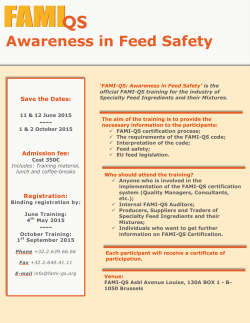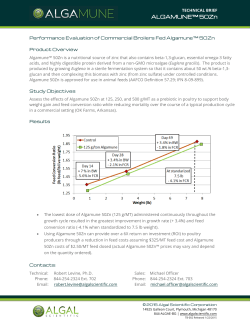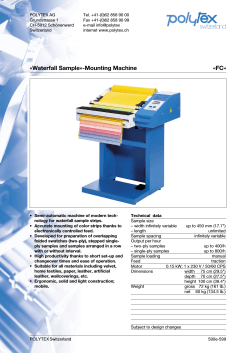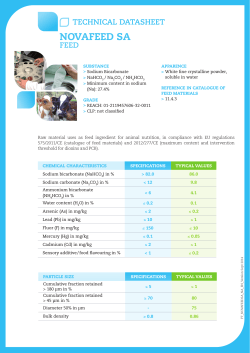
NEW YORK STATE
NEW YORK STATE RADIOLOGIC EMERGENCY PREPAREDNESS FOR THE AGRICULTURE COMMUNITY Date of Issue 2015 Please Keep this Booklet for Future Reference. 1 2 INGESTION PATHWAY PLANNING COUNTIES ........................................................................................................... 5 EMERGENCY INFORMATION .................................................................................................................................... 8 How You will be Notified ...................................................................................................................................................................8 Cornell Cooperative Extension - Extension Disaster Education Network ...........................................................................................8 Cornell Cooperative Extension Offices ...............................................................................................................................................9 PURPOSE................................................................................................................................................................ 10 DEFINITIONS .......................................................................................................................................................... 10 Ingestion Pathway ........................................................................................................................................................................... 10 Radiation ......................................................................................................................................................................................... 10 Nuclear Power Plant Emergency...................................................................................................................................................... 10 Radiological Contamination ............................................................................................................................................................ 10 PROTECTIVE ACTIONS ............................................................................................................................................ 11 What Are Protective Actions?.......................................................................................................................................................... 11 Giving Animals Protected Water ..................................................................................................................................................... 11 Protected Feed ................................................................................................................................................................................ 11 EMBARGOES AND QUARANTINES .......................................................................................................................... 12 Lifting an Embargo or Quarantine ................................................................................................................................................... 12 PERSONAL PROTECTION ........................................................................................................................................ 12 DECONTAMINATING LIVESTOCK ............................................................................................................................ 12 Buildings and Farm Equipment ........................................................................................................................................................ 12 FEED & WATER MANAGEMENT ............................................................................................................................. 13 SHELTERING ANIMALS ........................................................................................................................................... 14 MILK AND DAIRY ANIMALS ..................................................................................................................................... 14 Contaminated Milk .......................................................................................................................................................................... 14 MEAT ANIMALS AND MEAT PRODUCTS ................................................................................................................. 14 3 FRUITS, GRAPES, VEGETABLES AND NUTS .............................................................................................................. 14 POULTRY AND POULTRY PRODUCTS ...................................................................................................................... 15 GRAINS................................................................................................................................................................... 15 BEES AND HONEY................................................................................................................................................... 15 FISH, SHELLFISH, AND AQUACULTURE ................................................................................................................... 15 WILDLIFE AND CAPTIVE ANIMALS ON GAME FARMS ............................................................................................. 15 ALPACAS, HORSES, AND OTHER FARM ANIMALS ................................................................................................... 16 FOREST PRODUCTS ................................................................................................................................................ 16 SOIL AND WATER ................................................................................................................................................... 16 Protected Water Sources ................................................................................................................................................................. 16 Soil and Soil Management ............................................................................................................................................................... 16 FOOD AND MILK PROCESSORS, WAREHOUSES AND COMMODITY TERMINALS ..................................................... 16 Processors ....................................................................................................................................................................................... 16 Distributors ..................................................................................................................................................................................... 16 Warehouses and Terminals ............................................................................................................................................................. 16 PROTECTION OF PACKAGED FOOD PRODUCTS ...................................................................................................... 17 AFTER A RADIOLOGICAL EMERGENCY .................................................................................................................... 17 Re-entry .......................................................................................................................................................................................... 17 Relocation ....................................................................................................................................................................................... 17 Recovery ......................................................................................................................................................................................... 17 Reimbursement ............................................................................................................................................................................... 17 CHECK LIST ............................................................................................................................................................. 18 EMERGENCY PLAN ................................................................................................................................................. 19 4 Ingestion Pathway Planning Counties Indian Point Location: Westchester County Planning Area: 14 counties; States of Connecticut, New Jersey and Pennsylvania NY population: 12,078,106 (2010 Census) · Bronx · Dutchess · Kings · Nassau · New York · Orange · Putnam · Queens · Richmond · Rockland · Suffolk · Sullivan · Ulster · Westchester Nine Mile Point James A. FitzPatrick Location: Oswego County Planning Area: 10 counties Population: 1,333,644 (2010 Census) · Cayuga · Jefferson · Lewis · Madison · Oneida · Onondaga · Ontario · Oswego · Seneca · Wayne Robert E. Ginna Location: Wayne County Planning Area: 12 counties Population: 1,862,264 (2010 Census) · Cayuga · Genesee · Livingston · Monroe · Onondaga · Ontario · Orleans · Oswego · Seneca · Wayne · Wyoming · Yates Pickering Millstone Vermont Yankee Location: Canada Planning Area: 2 counties NY population: 119,305 (2010 Census) Location: Connecticut Planning Area: 1 county NY Population: 241,634 (2010 Census) Location: Vermont Planning Area: 3 counties NY population: 25,612 (2010) Census · Suffolk · Washington · Niagara · Orleans · Rensselaer · Columbia Darlington Location: Canada Planning Area: 2 counties NY population: 79,691 (2010) Census Oyster Creek Location: New Jersey Planning Area: 1 county NY population: 48,624 (2010 Census) · Niagara · Richmond · Orleans 5 6 7 Emergency Information How You will be Notified In the event of an emergency at a nuclear power plant, emergency broadcasts will be made on television and radio stations. These broadcasts will provide instructions on what you should do. Watch your television or listen to your radio for Emergency Alert System (EAS) messages, news briefings, and regular updates to learn what actions are being taken, and what recommendations are being made by officials. Information regarding the safety and handling of food, water, and livestock will be provided through press releases and briefings from local officials. This information will also be made available through Cornell Cooperative Extension – Extension Disaster Education Network. Cornell Cooperative Extension - Extension Disaster Education Network Each Cornell Cooperative Extension county office is a member of the New York Extension Disaster Education Network (NY EDEN), and is therefore a direct line to state-of-the-art emergency preparedness and response resources available at the nation’s finest Land Grant Universities through the national Extension Disaster Education Network (EDEN). NY EDEN is a partner of New York State Department of Agriculture and Markets for emergency and disaster preparedness and response. The Director of the NY EDEN is Keith Tidball, PhD. KGTidball@cornell.edu 607-254-5479 For real-time updates regarding an emergency, especially information regarding the agricultural sector, it is advised that you sign up for updates via the NY EDEN social media offerings (Twitter and/or Facebook). NY EDEN Twitter -- https://twitter.com/CCE_Disaster NY EDEN Facebook -- https://www.facebook.com/CceEden 8 Cornell Cooperative Extension Offices Your local Cornell Cooperative Extension office will be involved in assisting with important communications and information sharing, as well as gathering needs-assessment information when appropriate. Albany Allegany and Cattaraugus Broome Cayuga Chautauqua Chemung Chenango Clinton Columbia and Greene Cortland Delaware Dutchess Erie Essex Franklin Fulton and Montgomery Genesee Hamilton Herkimer Jefferson Lewis Livingston Madison Monroe Nassau Niagara Oneida Onondaga Ontario Orange Orleans Oswego Putnam Rensselaer Rockland Extension Administration 518-765-3500 585-268-7644 607-772-8953 315-255-1183 716-664-9502 607-734-4453 607-334-5841 518-561-7450 518-622-9820 607-753-5077 607-865-6531 845-677-8223 716-652-5400 518-962-4810 518-483-7403 518-673-5525 585-343-3040 518-548-6191 315.866.7920 315-788-8450 315-376-5270 585-991-5420 315-684-3001 585-753-2550 516-433-7970 716-433-8839 315-736-3394 315-424-9485 585-394-3977 845-344-1234 585-798-4265 315-963-7286 845-278-6738 518-272-4210 845-429-7085 607-255-2237 St. Lawrence Saratoga Schenectady Schoharie and Otsego Schuyler Seneca Steuben Suffolk Sullivan Tioga Tompkins Ulster Warren Washington Wayne Westchester Wyoming Yates Oneida Onondaga Ontario Orange Orleans Oswego Putnam Rensselaer Rockland Saint Lawrence Saratoga Schenectady Schoharie and Otsego Schuyler Seneca Steuben Suffolk CCE Agricultural Area Teams 315-379-9192 518-885-8995 518-372-1622 518-234-4303 607-535-7161 315-539-9251 607-664-2300 631-727-7850 845-292-6180 607-687-4020 607-272-2292 845-340-3990 518-623-3291 518-746-2560 315-331-8415 914-285-4620 585-786-2251 315-536-5123 315-736-3394 315-424-9485 585-394-3977 845-344-1234 585-798-4265 315-963-7286 845-278-6738 518-272-4210 845-429-7085 315-379-9192 518-885-8995 518-372-1622 518-234-4303 607-535-7161 315-539-9251 607-664-2300 631-727-7850 607-255-5225 9 Purpose This booklet is provided to inform the agricultural community about protective actions that may need to be taken if a radiological emergency occurs at a nuclear power plant within New York, or in a neighboring state or province. This booklet also contains information on how you would be notified and what procedures you may be asked to follow. New York State and local officials have developed emergency response plans to support and serve the agricultural community in the event of a nuclear power plant emergency. This booklet is intended for farmers, agricultural workers, livestock and poultry owners, fruit and vegetable growers, gardeners, food producers, processors and distributors. Definitions Ingestion Pathway The Ingestion Pathway Zone is an area extending outward in a radius of fifty (50) miles from a nuclear power plant. You will see this illustrated on the map on page 6. This includes areas in New York that are within fifty miles of a power plant in an adjacent state or province. When radioactive material is released from a nuclear power plant, it may be deposited on crops, gardens, pastures, and surface water within this 50 mile area. Individuals in this area may risk exposure caused by ingesting radiologically contaminated foods and water. Radiation Radiation is present at low levels in our environment all of the time. Naturally occurring radioactive material can be found in soil and in buildings. Radiation comes from other sources such as the sun, and X-ray machines when they are activated. The effects of radiation on people and animals depend on the amount and length of time of exposure, and the general health and age of the person or animal. Radioactive gases and particles can be inhaled, ingested, and absorbed into the skin. Nuclear Power Plant Emergency A nuclear power plant emergency may involve a release of radioactive gases and tiny particles into the atmosphere. The gases and particles are spread by the wind and eventually the particles fall and collect on the ground. The distance that gases and particles travel depends on the weather. Strong winds spread lighter particles over large areas, while heavier particles fall more quickly. Rain can also force radioactive particles to fall and concentrate in an area. Radiological Contamination Radiological contamination is the presence of radioactive material in unwanted locations. If, during a nuclear power plant emergency, a release of radioactive gases and particles occurs, it is possible that people, animals, crops, animal feed, water, plants, soil and farm equipment may become contaminated. The primary concern of contamination is the possibility that people and animals may eat, drink or breathe in the radioactive material, or absorb it through their skin. Once radioactive material enters the body it has the potential to cause health problems. Your concern as a farmer or food producer is the possibility of radiological contamination entering the human food supply by way of contaminated crops, feed, water, and livestock. Contamination may be passed from plants and animals through milk, meat, and other farm produce to humans. 10 Protective Actions If you are a farmer within 50 miles of a nuclear power plant, actions may be necessary to protect food, feed, water, and livestock in the event of a nuclear power plant emergency. Following a release of radioactive gases and particles, State agencies will send teams to collect samples and conduct tests to determine if contamination occurred. If food and water becomes contaminated, some protective actions will be necessary. Information and instructions will be provided by local, state and federal officials through press releases and press briefings. What Are Protective Actions? Protective Actions are actions taken to prevent or reduce health risks from contamination to people, livestock, and food products. For example, an agricultural product quarantine or embargo may be established until sampling can be performed and testing can confirm that products such as milk and produce are found to be free of contamination. Giving Animals Protected Water Animals need water to survive. Even if you have no protected feed during a radiological emergency, animals can live for several days on water alone. You may be advised to place animals on protected water. Water from closed containers, and underground sources such as covered deep wells and springs are considered protected, and will be safe for livestock. Water in open ponds or streams could be contaminated and should not be used until you are told it is safe to do so. Protected Feed You may be advised to place animals on protected feed. Protected feed means feed that has not been stored in the open, or exposed to radioactive contamination. Animal feed that is kept in enclosed barns, sheds, granaries, silos, and intact AgBags is considered protected feed. If feeding from covered trench or bunker silos with open ends or opened Ag-Bags, remove and discard the first six to twelve inches of silage from the exposed ends where contamination may have occurred. Feed which is not considered protected is feed stored outside and directly exposed to air and rain. This includes feed stored in cribs and sheds with open sides, uncovered hay stacks or bales, uncovered trench silos, bunkers, and upright silos without doors. During an emergency you may need to ration your on-hand supply of protected feed and water. The table on page 12 provides sustenance level feed and water guidelines for common farm animals. Keeping the animals alive is the goal. In addition, these levels will not support high milk production. This may be beneficial if you are faced with a temporary agriculture quarantine. Refrain from offering high quality forage to milking cattle to decrease milk production until you are able to return to regular production. Hay should be based on about 2.5% of body weight on a dry matter basis. 11 Embargoes and Quarantines During and following a radiological emergency, State officials may restrict the movement of food products and withhold them from the marketplace, within the 50 mile ingestion pathway zone, to reduce the chance of contaminated products entering the human food supply. This includes wholesale and retail markets, farm stands, and farmers markets. These products should not be released until they are deemed safe, or until a decision is made to dispose of them. You will be instructed how to safely handle and dispose of contaminated food products, and how to decontaminate your animals and property if necessary. Contaminated food will be isolated to prevent it from exposing non-contaminated food, and from accidentally entering the marketplace. State officials will determine whether disposal of contaminated products is appropriate and necessary. Lifting an Embargo or Quarantine After sampling and testing results show that food products are safe, State officials will lift embargoes and quarantines in previously restricted areas. Sampling and testing will be completed as quickly as possible to determine which areas are safe to lift embargoes. Personal Protection Depending upon the amount and type of radioactive material deposited, there may be a period of time when you may not be able to cultivate your land. Agriculture, environment, and health officials will sample, test, and monitor the area to determine the level of risk; and provide instructions on how to work safely on your farm. You may be told to take the following precautions: Wear protective clothing (similar to that worn during pesticide applications) when working outdoors. Remove all outer clothing before entering your home, livestock barns or milking parlors where you could contaminate your livestock and milking equipment. Wear a dust mask or dampened cloth over your nose and mouth if you are plowing, cultivating, disking, baling, or harvesting. Consult with State officials about the disposal of protective clothing and dust masks. Shower after completing outdoor activities. Wash hands thoroughly before you eat. If windows were open in your home or barn during the emergency, wash the surfaces where contaminated materials could have deposited. Decontaminating Livestock Livestock that have been fed protected feed and water, but exposed to external contamination, could be used for food if adequately washed and monitored by officials before slaughtering. Animals can be washed using soap and water. You should wear protective clothing similar to that used in pesticide applications to prevent contaminating yourself while handling and washing animals. Buildings and Farm Equipment Buildings and equipment may also be contaminated by radioactive particles. State officials will provide information on how best to decontaminate buildings and equipment. You may be told to wear protective clothing and wash down buildings and equipment with soap and water. 12 Feed & Water Management The following table provides general estimates. It does not take into account differences in production, breed, and other management factors. This table will give you a starting point for calculating the supply you may need to store in case of an emergency. Animals Estimated Water (Per day) Estimated Feed (Per day) In Production And Dry Cows 9 Gallons in Summer and 7 ½ Gallons in Winter 20 Pounds Hay Weaned Calves 6 Gallons in Summer and 3 Gallons in Winter 8-12 Pounds Hay Cow (Pregnant) 7 gallons in Summer and 6 Gallons in Winter 10-15 Pounds Hay Cow with Calf 9 Gallons in Summer and 8 Gallons in Winter 12-18 Pounds of Hay Calf (400 Pounds) 6 Gallons in Summer and 3 Gallons in Winter 8-12 pounds Hay Brood Sow with Litter 4 Gallons in Summer and 3 Gallons in Winter 8 Pounds Grain Brood Sow (Pregnant) 1-2 gallons Summer and 1 Gallon in Winter 2 Pounds Grain 150 Pound Gilt or Boar 1 gallon 3 Pounds Grain Ewe with Lamb 4 Quarts 5 Pounds Hay Ewe, Dry 3 Quarts 3 pounds Hay Weaned Lamb 2 Quarts 3 Pounds Hay Layers 5 Gallons/100 Birds 7 lbs./100 Birds Broilers 5 Gallons/100 Birds 10 lbs./100 Birds Turkeys 12 Gallons/100 Birds 40 Lbs./100 Birds CATTLE SWINE SHEEP POULTRY HORSES 1000 lb. horse Foals 8-15 Gallons – depending on 15-20 lbs. hay, normal grain – activity depending on activity 1 Gallon/100 lbs body wt. 2.2 lbs hay/100 lbs body wt, 1 lb grain 13 Sheltering Animals You may be asked to shelter your farm animals. This will help prevent radioactive contamination from harming your animals, and from entering the human food supply. Barns, milking parlors, machine sheds, garages, corn cribs, and swine or poultry buildings are all possible livestock shelters. An open building, such as a pole barn, provides the least amount of protection. If shelter is limited, dairy cows and other milk-producing animals should be given priority, because these animals can pass contamination on to humans through their milk. Egg producing fowl (layers) and meat fowl (broilers) should also be given priority, because contamination of eggs and poultry products can also enter the human food supply. In addition, you may want to consider putting your best breeding stock and calves, especially newborns with lactating cows, in protected shelter. Bulls, steers, and young weaned heifers may be a lower priority. Dry cows may be a lower priority as well. Although ventilation systems are needed to keep sheltered livestock healthy, they allow radioactive materials to enter the building. Therefore, it is important to limit outside air from entering the building to the least amount necessary for the animals’ safety. Do not use fans for ventilation unless absolutely necessary. Milk and Dairy Animals 1. Remove all dairy animals from pasture and shelter them. 2. Give dairy animals protected feed and water. When a release of radioactive materials has occurred, State officials may visit farms in the area to take samples of milk, feed and water to test for contamination. They may recommend that milk and dairy products not be consumed or sent to market until test results show that it is safe. Milk should be safe if it is from dairy animals that were sheltered properly and placed on protected feed and water. If dairy animals are not sheltered properly, eat food and drink water from uncovered sources, radioactive contamination may be absorbed into their bodies and could enter the human food supply. Contaminated Milk If dairy products are found to be contaminated, it will be recommended that milk and milk products be withheld from the marketplace. However, it is possible for milk products contaminated with very low levels of radioactive material to be deemed safe by officials for human consumption. Time will also reduce the amount of radioactive material present in milk. Fluid milk can be kept for long periods of time using ultra-high temperature pasteurization, which may allow radioactive material to decay to a safe level. In addition, producing cheese, dry milk, butter, yogurt, ice cream and evaporated milk using fluid milk may be an alternative to store product and allow the radioactivity to decrease. Meat Animals and Meat Products You may be asked to place meat animals on protected feed and water, and to shelter them. If livestock consume contaminated feed and water, some of the contamination will be absorbed into their bodies and could then enter the human food supply through meat and meat products. Meat animals with internal contamination should not be slaughtered until you are told that it is safe to do so by State officials. Instructions will be given on a case by case basis. Fruits, Grapes, Vegetables and Nuts Officials may recommend that you wash, scrub, peel, and/or shell all locally grown fruits, vegetables, roots (such as carrots), tubers (such as potatoes), and nuts to remove any surface contamination. Fruits and vegetables ripe at the time 14 of a radiological release may be lost because of the risk to humans while harvesting the contaminated fruit. Fruits and vegetables that do not have to be picked immediately could be picked and cleaned after State officials verify that the radioactive levels are safe and/or have decreased. Canning, freezing or storage of fruits and vegetables will also allow radioactive levels to decay. Fruits and vegetables should not be consumed or sold until you are told that it is safe to do so by State officials. Harvesting, processing or consumption of wild foods such as mushrooms or berries should be controlled in the same manner as fruits, grapes, vegetables and nuts. Poultry and Poultry Products Officials may recommend that your poultry are put on protected feed and water, and provided shelter. Poultry raised outdoors, especially those kept for egg production, may be sampled by officials to determine if eggs have radiological contamination. Poultry raised indoors and given protected food and water are less likely to be contaminated. Reduce ventilation in chicken coops and shelters if possible. Ventilation and fans that draw air in from the outside can pull in contaminated particles from outdoors. If poultry products and eggs are found to be contaminated, they should not be eaten and they should not go to market. Grains If grains are permitted to grow to maturity, most contamination may be removed by the wind and rain. Milling or polishing will likely remove any remaining contamination. It can take a month from the time grains are harvested until they reach the consumer, sampling and laboratory analysis will determine if the grain is safe to use. When harvesting potentially contaminated grain, it should be stored separately from grain harvested and stored before the emergency. Bees and Honey Honey and beehives may also need to be sampled and analyzed by officials if radiological contamination is found in the area. Fish, Shellfish, and Aquaculture Little can be done to protect wild fish and shellfish from radiological contamination in their natural habitat. If approved by Department of Environmental Conservation officials, catch and release fishing may be conducted within the area affected by the emergency. But, fish and shell fish should not be harvested for consumption until samples have been tested and determined to be safe. Fish and shellfish raised in ponds, marine waters, or raceways should not be harvested or consumed until samples have been tested and determined to be safe. Wildlife and Captive Animals on Game Farms Wildlife should not be harvested for consumption within the area affected by the emergency until tested and determined to be safe by the Department of Environmental Conservation. To the extent that it is possible, wild birds and animals such as deer being raised at game farms within the affected areas should be fed protected feed and water; and where possible be provided shelter. Whether or not they were protected, they should not be sold, released, or harvested until approved by State authorities. 15 Alpacas, Horses, and other Farm Animals Animals should be sheltered in a safe enclosure that will not pose danger or stress to the animals being housed. Care should be taken to ensure safe sources of water and feed until restrictions are lifted for other agricultural species. As these animals are not related to food production, it is unlikely that any testing will occur. For horses in particular it would be beneficial if an enclosed area is available that could be used for exercise, as these animals need exercise to maintain their health. Forest Products While there is a low potential for significant contamination of forest products such as logs, firewood, or Christmas trees, they should not be harvested or removed from the impacted area until evaluated and approved for use by the Department of Environmental Conservation. Soil and Water Protected Water Sources Covered wells, covered rain barrels, and covered tanks not connected to surface water are protected water sources. Storage containers that are supplied by runoff from roof tops or other surface drain fields are not protected water sources. Disconnect filler pipes from these unprotected water barrels and tanks to prevent contamination from being washed into the storage container. Water in unprotected storage containers (ones that were not disconnected from surface water sources) should not be used for irrigation or human or animal consumption unless evaluated and approved by State officials. Soil and Soil Management If soil contamination occurs, proper soil management procedures could be implemented to reduce contamination: (1) Idling or non-use of the land for a period of time may be necessary in some cases; (2) Changing the type of crops to nonfood/feed crops such as fiber crops of cotton and flax; (3) Deep plowing may keep radioactive material below the plant root zone where the radioactive material can decay and limit absorption by crops. State officials will provide guidance on proper soil management. Food and Milk Processors, Warehouses and Commodity Terminals Milk and food products in an affected area can become contaminated during collection and processing. After a radiological emergency, State officials may restrict shipment of food products to reduce the chances of contaminated food products from entering the human food supply. Processors—State officials may take samples of food, produce, and finished products for contamination analysis. After testing, they will determine if products are safe for processing and distribution. Distributors – State officials may inspect shipments to check for contamination. After testing, they will determine if the shipment is safe for distribution. This testing may take several days. Do not release products until they are deemed safe. Warehouses and Terminals - Windows and vents to the outdoors should be closed. Vacuum systems should be shut down as should compressed air systems. Any system that draws air from outdoors to the inside should be shut down. Samples of products may be collected and tested to determine whether or not they have been contaminated, and which products are safe and can be released. 16 Protection of Packaged Food Products Food in finished packaging, during the time of the radiological material release, should not be harmful to eat as long as the outer wrappings are discarded. Radioactivity will travel as fine particles that may coat the outside of the food product container. State officials will provide further advice to avoid any contamination from the outside packaging. After a Radiological Emergency Re-entry Re-entry is the controlled, temporary entry into a restricted, contaminated area. If you have been evacuated, you may be allowed to return temporarily to your farm when conditions allow. State and local officials will advise you through EAS broadcasts and other means, if re-entry has been allowed. You will receive instructions on what routes to use and safety precautions to take. Re-entry will allow you to perform critical activities such as milking, watering and feeding of farm animals. Relocation Relocation of people from homes, farms and/or communities may be necessary when the exposure to deposited radiological contamination is unsafe for people to return and stay. Recovery Recovery is the process of reducing radiation in the environment to acceptable levels for normal daily living. Following an emergency, State and local officials will identify the types and levels of contamination. They may need to take samples of air, water, soil, crops and animal products from your farm or business. They will provide you with instructions on how to decontaminate your animals, food, and property. Reimbursement Federal law requires nuclear power plants to participate in an insurance pool to cover legitimate claims for losses as a result of a radiological emergency. 17 Check List Shelter all farm animals, especially dairy producing animals. Feed and water livestock from protected sources. Bring feed into building, or cover it if outdoors. Store as much water as possible for livestock in enclosed wells or containers. Cover wells, rain barrels and tanks. Delay grazing on pasture until you are told it is safe to do so. When you go outside, wear outer clothing that covers all areas of your body, similar to what you would wear if applying chemicals (e.g. Hats, gloves, boots, coveralls, long shirts and long pants). Remove outer clothing before going indoors. Once inside wash your hands and face immediately. Do not use fresh milk, meat, fish, eggs, fruits or vegetables from your farm or garden until they are sampled and tested or until officials tell you it is safe to do so. Do not stir up dust from activities such as cultivating, baling, disking or harvesting. Do not slaughter any animals until officials tell you it is safe to do so. Do not process or distribute agricultural products or food products until they are sampled by State officials, or you are told it is safe to do so. This process may take several days. Do not destroy agricultural products until officials say it is necessary or safe to do so. Do not fish or hunt in the embargo area until authorities tell you it is safe to do so. Do not harvest wild foods such as mushrooms or berries in the embargo area until authorities tell you it is safe to do so. 18 EMERGENCY PLAN Name of Farm: Farm Contact Person: Farm (Physical) Address: Town: Zip Code: Global Position System (GPS), Geographic Information System (GIS) location: Phone Numbers: (Home) (Cell) Fax or Email: Local Emergency Services (911): Police: Fire: Emergency Medical Team: Animal Needs: Veterinarian Name: Phone Numbers: (Office) (Cell) Animal Medications: Animal Medical Records: Available Protected Animal Feed: Grain Stored in Bins: Hay Stored in Barn/Covered Shed: Hay Bales Covered by Tarp/Plastic: Ensilage Stored in Covered Silo: Ensilage in Covered Trench/Bunker: 19 Available Protected Water: Enclosed Container: Freely Running Spring (covered): Rain Barrels (covered): Deep Wells (covered): Generator to Pump Water: Troughs: Other Source: Livestock: First Priority Animals: Shelter/Location: Amount of Protected Feed Required for 7 days: Amount of Protected Water Required for 7 days: Power/Generator: HV/AC: Poultry Animals: Shelter/Location: Amount of Protected Feed Required for 7 days: Amount of Protected Water Required for 7 days: Power/Generator: HV/AC: Other Animals: Shelter/Location: Amount of Protected Feed for 7 days: Amount of Protected Water for 7 days: 20 21
© Copyright 2025









